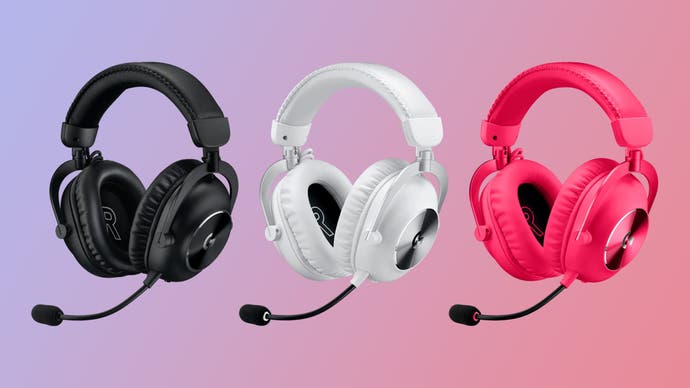Best PC gaming headset 2024: 10 options from casual to esports-grade
Wired and wireless, cheap to ultra-premium.
Here are some of the absolute best PC gaming headsets available, based on a full decade of testing. We've got wired and wireless options, cheap headsets that won't break the bank and premium options that justify their higher prices. As well as the big names like Turtle Beach, Razer and Logitech, we've also highlighted headsets from smaller firms like Epos and Audeze that are absolutely worth knowing about.
The idea here is to give you a few options to choose from without being overwhelming, so that you can pick up a new headset at the right time - whether that's when you want to start seriously trying to improve at Counter-Strike 2 or when your Warzone buddies tell you off for missing those crucial footsteps. We're focusing on headsets for PC here, but many of these options will work on Xbox Series X/S, PS5 or both - and you can see our full gaming headset recommendations for a deeper list if you prefer.
Click the links below to jump to a headset you're interested in, or scroll on for the full list!

Best PC gaming headsets 2024
- Razer Blackshark V2 X: the best value option
- Logitech G Pro X 2 Lightspeed: the best overall but expensive
- Logitech G335 / G435 Lightspeed: cheap, comfy, great
- Audeze Maxwell: big, expensive, phenomenal
- Acezone A-Spire / A-Rise: premium esports headsets with ANC
- HyperX Cloud 3 Wireless: a long-endurance wireless headset
- Epos H6Pro: open and closed back variants, often discounted
- Turtle Beach Recon 500: great value, multiple colours
- Roccat Syn Max Air: excellent features, some challenges
- Audeze LCD-GX: ultra-premium excellence
We've also created some bonus features for you to peruse at the end of the article. You can check out our (small but growing) section called Best of the Rest for more of our PC gaming headset recommendations, see our picks for the best PC gaming audio accessories or see the answers to some frequently asked questions.
Now, on with the recommendations!
Looking to get the ultimate PC gaming setup? We've rounded up the best gaming keyboards and best gaming mice on the market including trendy ultra-light options. We've also got recommendations for our favourite high refresh rate monitors, including some great 4K TVs for gaming that go great with the best controllers for PC. If you're making YouTube videos or streaming on Twitch, you should take a look at our gaming mic recommendations too!
1. Razer Blackshark V2 X
Our top wired headset for the money, comfy and accurate with fancier wireless variants
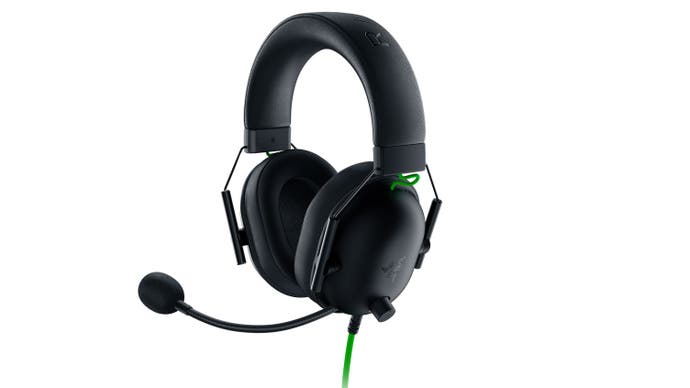
The £39/$50 BlackShark V2 X is the best wired headset for the money we've tested. First, these headphones are a treat to use for gaming or music, with a wide sound stage, accurate sound and good imaging provided by large 50mm drivers.
This is a stereo headset by default, which we recommend for competitive play, though you can use Razer's 7.1 surround sound app or the surround profiles built into Windows like Windows Sonic for surround sound on PC. The mic is also great for in-game comms, although we'd recommend a more professional-grade alternative for streaming. In terms of connectivity, dual and single 3.5mm are provided - though of course you could plug this into a USB DAC/AMP if you prefer it to your onboard sound card.
The BlackShark V2 X's design is also worthy of some praise. For starters, the ears are well sealed to block out distracting background sounds - useful whether you're clutching in CS2 or working from home. The athletic-knit-covered memory foam ear pads remained comfortable for hours, no doubt aided by the light weight of the headset - just 240g. There's a convenient volume knob on the left earcup, and the microphone is removable. The BlackShark V2 also lacks any kind of RGB lighting, with only a few green-coloured cables to identify it as a gaming headset.
If you'd prefer a wireless headset that retains the same great comfort and sound quality, the £99/$130 BlackShark V2 Pro released in 2020 is well worth considering at its reduced price. A later BlackShark V2 Pro 2023 revision also exists which we've tested and recommend, although at £199/$199 its qualities - three times longer battery life, USB-C charging, incredible microphone and Bluetooth support - aren't yet worth the extra money. Once the premium drops to £40/$50 or less, I'd say that it starts becoming worth it!
2. Logitech G Pro X 2 Lightspeed
A sterling headset with 50mm graphene drivers, low-latency wireless and multiple ear pads

Logitech have made some legendary gaming headsets in their day, and their best yet is the Logitech G Pro X 2 Lightspeed. This £249/$249 ultra-premium option sports a low latency 2.4GHz Lightspeed connection that feels just as immediate as a wired headset. It's also supremely comfortable, even for the glasses-wearers, with both velour and leatherette ear pads in the box, and boasts impressive build quality with plenty of metal evident. This new model even contains a new hinge that allows the headphones to lie flat and better accommodate the positioning of your ears.
The 50mm graphene drivers inside provide detailed and neutral sound, with a slight emphasis to mids that can help highlight footstep sounds. Surround sound is effectively provided by 3D Audio on PS5 or DTS Headphone:X on PC.
In terms of connectivity, you're looking at wireless 2.4GHz via a USB dongle for PC/PS5, Bluetooth for mobile devices and a 3.5mm wired connection for Xbox or other devices without USB audio or Bluetooth support. Wireless headphones tend to suffer in mic quality, and unfortunately this one relies quite heavily on Blue Voice software on PC to become serviceable - it's notably behind other wireless options like the Corsair HS80 RGB Wireless and the Razer BlackShark V2 Pro (detailed in our number one pick above).
Battery life is excellent, at around 50 hours, with quick and easy USB-C recharging. One area I'd like to particularly highlight is usability; Logitech has done well to incorporate a large number of controls (power switch, volume wheel, mic mute) onto a single earcup while ensuring each has a distinct feel. This is backed with the G Hub software, which is attractively designed and logically laid out.
Overall, the G Pro X 2 Lightspeed is an outstanding pick for any competitively-minded PC gamer - though at full price it's undoubtedly one of the most expensive gaming headsets on the market.
Thankfully, if you need a cheaper option the original £153/$180 G Pro X Wireless headset costs less and sounds nearly as good, despite lacking the graphene drivers of the newer model. The similar-era wired £88/$120 G Pro X is getting harder to find but costs significantly less, while retaining most of the comfort and usability of the higher-tier design.
3. Logitech G335 / G435 Lightspeed
Comfy and colourful mid-range headsets, available wired or wireless
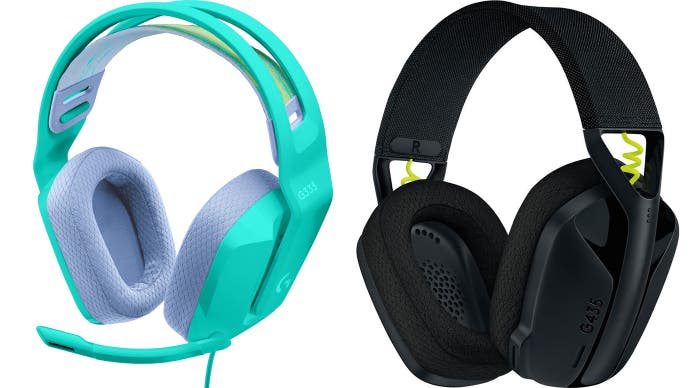
Logitech's lightweight gaming headsets were a pleasant surprise when they launched a couple years back and they remain great options at their new lower prices. The wired Logitech G335 (£45/$50) and the wireless G435 Lightspeed (£50/$50).
The sound quality of these headsets are nothing special - I'd rate the Razer BlackShark V2 X or Turtle Beach Recon 500 as the better-sounding headsets for music and single-player games - but it's clear enough with a neutral signature that works well for multiplayer gaming. Instead, the G335 and G435 distinguish themselves from an aesthetic, comfort and usability standpoint, with a supremely comfortable fit for those with small to medium-size heads thanks to a lightweight design and ski-goggle-style fabric headband. And when I say lightweight, I'm talking 240g for the wired G335 and an ridiculous 160g for the wireless G435.
The headsets comes in three colours each, with the reversible headband offering a choice of two accent colours (there are also two mounting positions for the headband to accommodate smaller noggins). The flip-to-mute microphone on the wired G335 is easy to position and provides clear comms, while the G435 makes do with an integrated mic that doesn't sound quite as good. The G335's volume wheel on the left earcup is conveniently placed for mid-game adjustments, without being so prominent as to be adjusted accidentally while you're putting the headset on or taking it off. The G335 uses 3.5mm, so it works on a wide range of consoles and mobile devices as well as on PC, and I dig that it's coloured to match the headset. Meanwhile the G435 can be connected via Bluetooth or 2.4GHz wireless (via a USB dongle), but can't maintain both connections simultaneously and the USB port is for charging only.
If you want a convenient, comfortable and colourful headset there's nothing quite like these new Logitech headsets. The G335 is the more flexible option at a lower price, so that's our default recommendation. If you need or prefer wireless functionality, the G435 Lightspeed delivers the same design spec - super lightweight and comfy with great usability and good sound - with 2.4GHz wireless and Bluetooth at an even more competitive price for its category.
4. Audeze Maxwell
A refined planar magnetic wireless headset

The £319/$299 Audeze Maxwell is the best planar magnetic wireless headset we've tested so far. These drivers allow for excellent sound quality at the expense of bulk, and the headset is available in both PS5 and Xbox configurations - both of which work with PC too.
The Maxwell is defined by excellent clarity and separation, making it easy to pick out details even in chaotic soundscapes, with a slightly v-shaped sound overall and a surprisingly wide sound stage for a closed-back design. Combined with a good low latency audio connection via a 2.4GHz wireless dongle and a good microphone, and you get a terrific PC headset. The headset also offers Bluetooth and 3.5mm connectivity, allowing use with a wide range of other devices.
The Maxwell is also robustly constructed with plenty of metal, as you'd hope from a headset at this price range. It's quite heavy, as planar magnetic headsets often are, but it's relatively well balanced with less clamping force than the earlier Audeze Penrose design. Usability is good too, with convenient volume and game/chat mix dials and a prominent mic mute button. Battery life is also excellent at up to 80 hours.
Overall, a fantastic headset for both gaming and critical listening - if you're willing to accept the relatively high weight (490g) and high asking price.
5. Acezone A-Spire / A-Rise
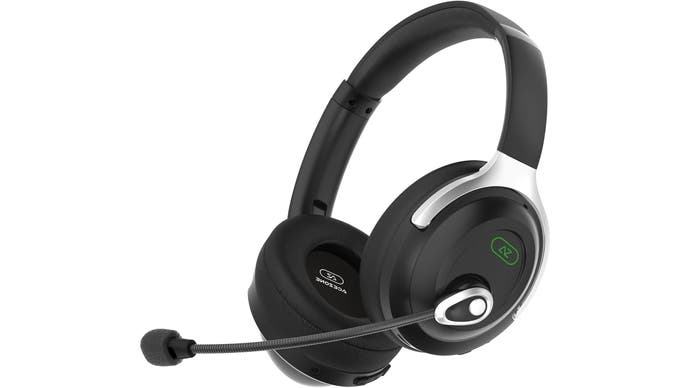
The Acezone A-Spire is a unique thing: a premium-grade esports headset with active noise cancellation that works both wired (via USB-C or 3.5mm) and via Bluetooth. That puts in a weird category, especially at its not insubstantial £199/$320 price point. And yet... this headset is utterly compelling in its competitive niche, offering a range of features and a level of quality that is almost unmatched.
The focus here is on making it as easy as possible for you to locate your enemies in FPS video games in three ways: by slightly raising mids while preserving detail and directionality; by reducing distractions using passive and active noise cancellation; and by being comfortable enough to not distract you. This three-part plan is executed with surprising success for a company building its first headsets, with excellent directionality evident in Counter-Strike 2 and Warzone in our testing, backed by reasonable comfort and effective ANC that made it very easy to focus on the match at hand.
Communication is also key for team-based games like CS2, so a good microphone is also required. Being a wired headset helps the A-Spire here, with a modestly-sized flip-down directional mic that produces perfectly acceptable results. I also like the ability to clip the mic to the headband when it's not in use, which isn't quite as sleek as a retractable option a la SteelSeries but no doubt allows for a significantly simpler design.
There are some oddities here too. Being able to change your settings in a mobile app makes sense in a competitive context where you're not allowed to run software on tournament PCs, but this may be a bit unusual for players used to PC software like iCUE or Synapse. At least it means that there's nothing running in the background of your PC to temper its performance, even if it does mean you have to deal with the unreliability of Bluetooth pairing.*
Other slight negative points include a design that is functional rather than aesthetic, with plastic parts throughout and relatively slim earcups that offer as much passive noise isolation as larger designs from the likes of Razer or Corsair - though the ANC of course makes this less of a big deal. Regardless, the A-Spire is laser-focused on delivering peak performance for esports, and that's nothing but commendable.

Acezone also make the A-Rise, which massively ramps up passive noise isolation with an upgraded design that includes incredibly thick magnetically-attached genuine leather earcups, a metal frame and an even better microphone. I found this an unparalleled headset for Counter-Strike, making it easy to pinpoint enemy footsteps even with significant noise in my playing environment. This costs £699/$749, a price that will cause even PC enthusiasts to think twice, but if you genuinely are a high-level FPS player interested in an esports career, it could still be worth the upgrade.
6. HyperX Cloud 3 Wireless
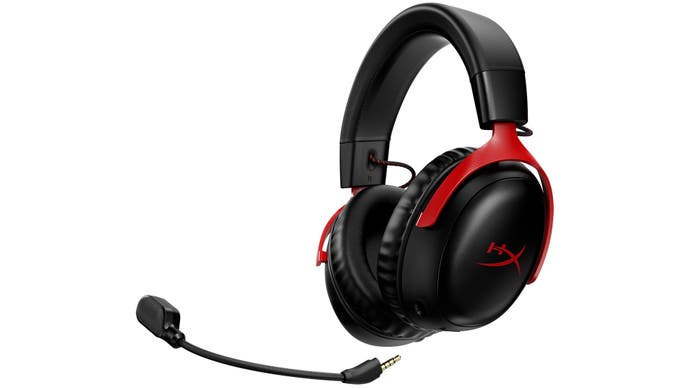
The £145/$115 HyperX Cloud 3 Wireless is a solid wireless gaming headset for PC and PS if you hate recharging, with a commendable 120-hour battery life and a lightweight, durable and comfortable frame in the tradition of the legendary HyperX Cloud 2. That makes for a very convenient headset to use, and I also appreciate the convenient on-headset controls and the detachable microphone, which you can remove if you're using a USB or XLR mic instead. The wireless dongle is USB-C with a USB-A adapter, so you can use this headset on PC handhelds like the Steam Deck and ROG Ally as well as desktop and laptop PCs which is handy.
Wireless performance is good, with no noticeable latency, and the Ngenuity app allows you to engage simulated surround sound (DTS Headphone:X), install firmware updates and change how the Cloud 3 Wireless sound using a graphic EQ. The latter is a good thing, as out of the box the Cloud 3 Wireless have quite a plain neutral sound, which is detailed enough for competitive use but perhaps not as exciting as v-shaped headsets with better bass delivery. Microphone performance is also good if not exceptional for a wireless headset, and I had no issues being understood in Counter-Strike or Helldivers.
Finally, it's important to note that the HyperX Cloud 3 Wireless is a much better deal in the US, where it's just over the $100 mark, while in the UK it remains a bit pricey at nearly £150. Hopefully we'll see some reductions on this headset over time, as there is some genuine quality here.
7. Epos H6Pro Open and H6 Pro Closed
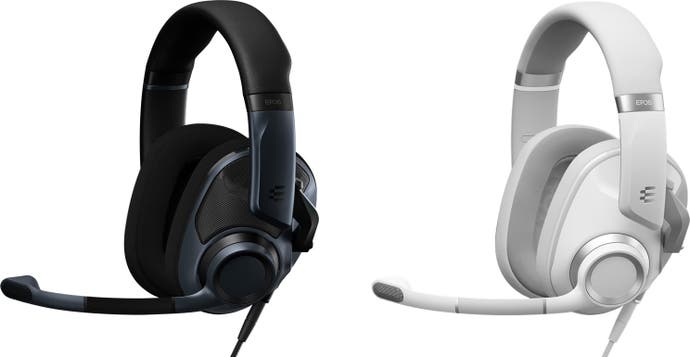
The £70/$90 Epos H6Pro is a well-built and great-sounding wired gaming headset - currently discounted as Epos is exiting the gaming space - and uniquely available in both closed and open-back configurations. This allows you to choose between better bass and noise isolation (closed) or a wider sound stage and greater awareness (open). I tend to prefer open back headphones for playing competitive shooters in a quiet room, and closed back headphones for playing more cinematic affairs in noisy or mixed environments, so it's nice that to have the choice between the two styles. In terms of sound signature, the headset is well-suited for gaming and good for critical listening, with plenty of detail and a bit of a bump to the bass frequencies.
Both configurations offer a robust (and detachable) flip-up microphone that offers good recording quality, plush earcups and a slimmer, lighter design than the old Epos Sennheiser GSP 600. These are all sensible changes, and they've been carried out without harming the headset's sound quality or build quality.
8. Turtle Beach Recon 500
A 60mm headset with excellent passive noise isolation and great imaging
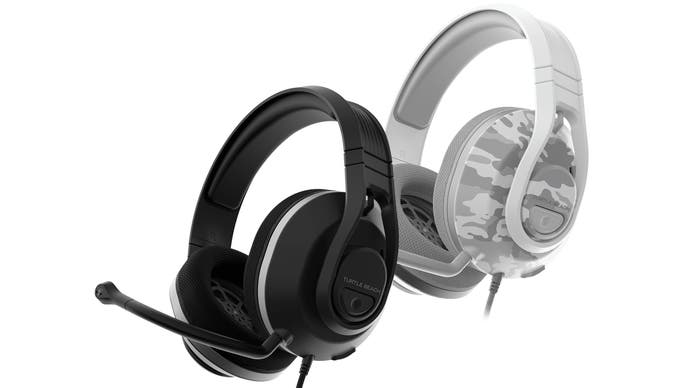
If you're looking for a simple wired headset that nails the essentials, the £52/$80 Turtle Beach Recon 500 is a great shout. In our testing, we found the lightweight headset comfortable to wear for long periods, even with glasses, with excellent passive noise isolation. The unusual 60mm dual drivers provide surprisingly detailed sound with good imaging, making them ideal for identifying the position of enemies in games like Apex Legends or Counter-Strike 2. The detachable microphone is only OK for a wired headset, but still beats out almost all wireless headsets we've tested.
The Recon 500 also seems quite well built, although its no-nonsense appearance and mostly plastic construction aren't eye-catching in the black colourway we tested - although an arctic camo version is also available. The headset uses a 3.5mm connection, so it works with PCs as well as PS5, Series X/S, Switch, many phones and tablets, and so on. The Recon 500 was a real surprise for us, so we're happy to recommend it here.
9. Roccat Syn Max Air
A redesigned Roccat headset with athletic fabric and charging dock
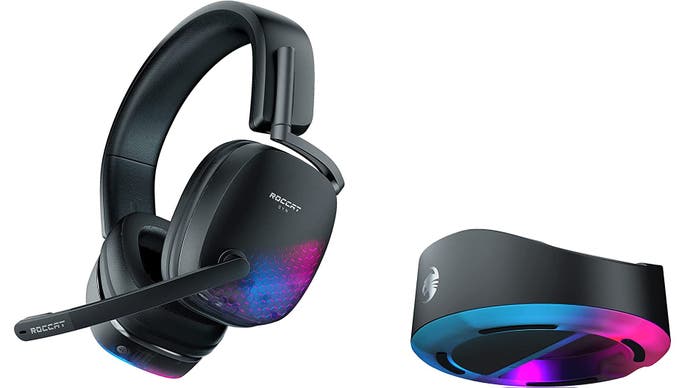
The £146/$139 Roccat Syn Max Air is a great headset with a few small issues that prevent it from reaching higher on our ranking. Its use of athletic fabric for the ear cushions and headband make it comfortable without getting sweaty in warm weather, but don't block out much outside noise. Elsewhere, RGB lighting peaks through a semi-transparent honeycomb on each ear, which looks neat and can be disabled to boost battery life. The controls are decent too, with infinitely-scrolling wheels on each ear cup for volume and chat/game mix, with buttons to turn the headset on and off and engage Bluetooth, which can be used simultaneously with the 2.4GHz connection.
It takes the headset some time to pair once it's turned on, and it produces three incredibly loud and piercing chimes while it's doing so - something we originally raised with the Syn Pro Air that hasn't been fixed for this model. You can at least lower the volume in the Roccat software, but why it has persisted is confusing given that no other headset does this.
The stereo sound the Syn Max Air produces is quite bass-heavy by default, with a bit of flab evident, but the neutral EQ setting improves things somewhat - or keep it on the standard setting for a more bombastic presentation. While USB-C charging returns, you're more likely to use the included (and RGB-enabled) docking station, which requires a lot of desk space but is easier than looking for a cable or swapping out a battery.
The Syn Max Air is a strong PC headset - comfy, aurally proficient and feature-rich - but its genuinely painful power on tone and other slight annoyances keep it from ascending higher on this list.
10. Audeze LCD-GX
An ultra-premium planar magnetic headset that absolutely delivers
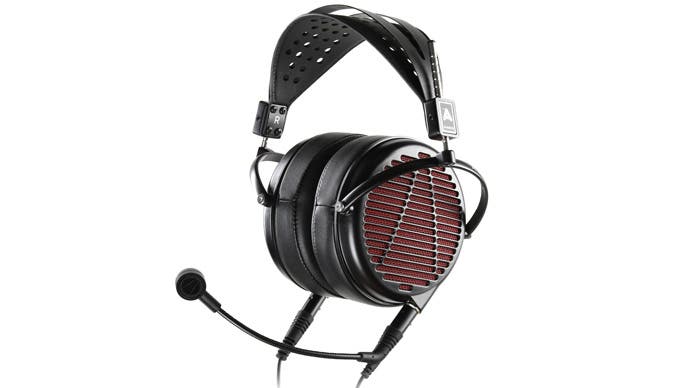
The £899/$899 Audeze LCD-GX is the most expensive gaming headset I've ever tested - so it's a good thing it's also the best-sounding. The LCD-GX uses massive open-back planar magnetic drivers to provide unparalleled sound quality, while a simple in-line microphone transforms it into a capable headset for gaming with friends. That's a powerful combination, and also one that feels more comfortable and convenient than adding a ModMic to the side of your favourite pair of audiophile headphones.
However, beyond the headset you don't get much in terms of gaming features - this is a wired 3.5mm headset with stereo sound, and there's nothing in the way of gaming-specific features like surround sound, equalisers, genre-specific modes, footstep highlighting or RGB lighting. That suits me just fine, especially as there are ways to add these features via software. Surround sound modes are built into Windows 10 and 11, with free Windows Sonic and paid-for Dolby Atmos, and third-party options exist too - including the Immerse Gaming Hive from audio firm Embody, who arranged for the LCD-GX to be sent out to us for testing.
The Hive software has you take a picture of your ear and select your headset to provide individualised surround sound, and the effect is pretty extraordinary on the LCD-GX. When combined with the GX's already incredible detail and wide sound stage, you get a much more immersive experience - and better audio clues about enemy positions in games that lack built-in HRTF audio. I tested it out in Call of Duty Vanguard, CS:GO and Forza Horizon 5, and in all but CS:GO having the surround sound enabled was a noticeable improvement over the default audio mix. I was also surprised by just how comfortable this headset is, despite a relatively high weight (454g) - perhaps down to the advanced materials used throughout, the suspension headband design and the thick memory foam ear cushions.
So if you're in the market for a high-end gaming headset and want the best of the best, the Audeze LCD-GX and a Hive subscription are a pretty solid combo, letting you enjoy exceedingly pure analogue audio for critical listening or a more processed, gaming-focused mix with the press of a button.
Best of the rest: more PC gaming headset recommendations
We're trying to limit our top recommendations here to just 10 headsets, so all others that we test and recommend will live here, including products that have been supplanted by new recommendations. We'll share one paragraph about what this makes this headset worth considering based on our testing, and if it's available at a good price in your region then it should be worth considering alongside our top picks.
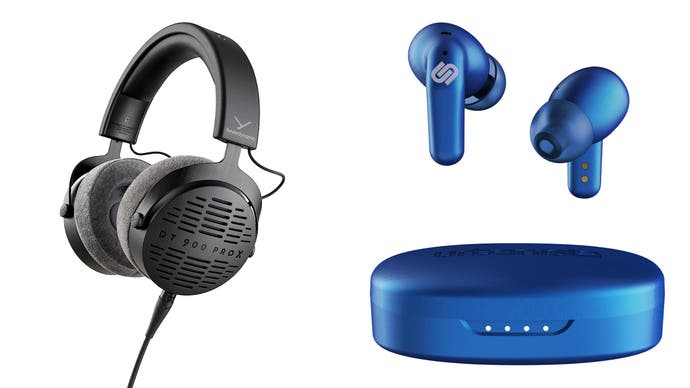
Urbanista Seoul: These £49/$59 Bluetooth in-ears have a relatively low 70ms latency figure, making them decent for mobile, PC handheld and laptop gaming, with a comfortable design, low-profile charging case that delivers up to 32 hours of battery life and attractive blue colour scheme. I wouldn't choose these for competitive gaming, but they worked well enough in my testing for more casual play sessions on the Steam Deck.
Beyerdynamic DT 900 Pro X: These £199/$269 open-back headphones lack a microphone, but if you have a USB or XLR mic they're a strong choice for anyone that prefers a neutral sound signature. These studio headphones are designed for professional use, with rugged and replaceable components including Mini XLR headphone cables, but also work well for gaming thanks to their wide sound stage, great imaging and bright nature. Of course, as with other open-back headphones, they leak sound in their environment and lack passive noise isolation, so they're not ideal for shared spaces.
Audio-Technica ATH-GL3: This £100/$100 headset is available in both closed back (earth) and open-back (air) varieties, offering neutral sound via 45mm drivers, a lightweight (230g) and plasticky design with a removable microphone and a simple wired 3.5mm connection. This is a simple headset with no gimmicks, just a focus on the fundamentals like sound quality and repairability, and it pays off in terms of performance - though perhaps material and design choices have reduced long-term comfort somewhat.
Rode NTH-100: Another pair of strong studio headphones we tested recently are the Rode NTH-100s. These £75/$149 headphones offers a closed-back design, with a warmer sound profile, lighter design and more comfortable fit than the (more expensive) DT 900 Pro X. As before, these headphones don't include a microphone, so you'll need a microphone elsewhere for communicating with your team-mates in multiplayer games.
Epos H3: Following the closing of Epos' gaming division, this headset is available for an extremely low price (£73/$57) and is well worth considering while it's still available. The sound quality is great, with a neutral profile and plenty of detail, and the microphone is one of the best we've heard at this price point. The industrial design here is impressive too, proving light and comfortable even while wearing glasses, and despite a more plasticky construction the H3 still feels robust in the hand. Compatibility is wide too, with two finely braided 3.5mm cables in the box. The only weirdness is the earcup volume dial, which requires time and effort to turn from its highest to lowest settings. Regardless of this minor annoyance, the Epos H3 is an excellent translation of the company's traditional strengths - audio quality, build quality and comfort - down to a more mainstream price point, and for that it deserves a mention here if not a top placing.
Turtle Beach Recon 70: a great budget (£30/$40) headset for PC gaming that also works with a wide range of consoles via 3.5mm. The short microphone has a flip to mute function, something we normally only see on more expensive models, and actually sounds pretty good although it's not great at rejecting outside noise. The sound is quite neutral, with slightly flabby bass and only decent imaging, and it works fine for most gaming and music that isn't bass-heavy. We also liked the physical design; the light weight of the headset and reasonably plush earcups make for a headset that is comfortable enough to not be noticeable for an hour or two of gaming. However, the headset does feel a little creaky in the hands, and may not hold up to continued use as well as mid-range options like the Recon 500. The Recon 70 is available in a wide range of colour schemes too. For the price, especially in the UK where it's often available near the £20 mark, this is a very decent headset.
The best PC gaming audio accessories
Best 3.5mm amp: Helm DB12 AAAMP
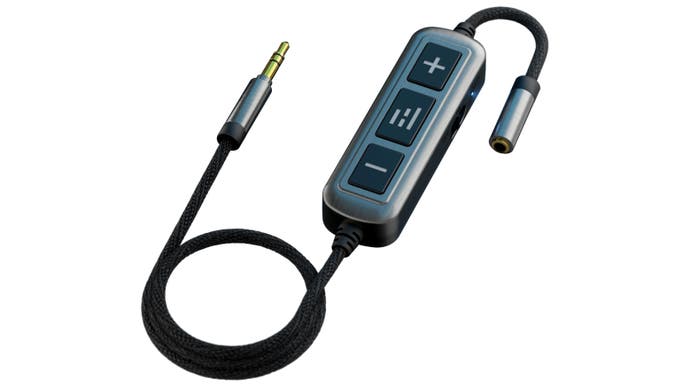
If you want to give our 3.5mm headphones a little more punch, you can combine them with the £150 DB12 AAAMP. This tiny gadget boosts your headphones by up to 12dB, with an optional bass boost on top that provides a deeper sound ideal for cinematic games or electronic music. The amplifier adds no discernible distortion, even with the bass boost option enabled, and really impressed me when I paired it with Sennheiser HD 598 SE headphones. The unit's battery is charged via USB-C, and lasts for five or six hours of listening at an average volume. Once the battery is exhausted, you can simply switch the unit from 'bass boost' or 'on' to off, and the DB12 will pass on the audio sans amplification. The DB12 also includes large, easy-to-find buttons for adjusting the volume, summoning voice assistants and skipping tracks, which is great for headphones that don't have an in-line remote, especially when you're using them with a smartphone. The cost of entry here is substantial, but the results are pretty incredible too.
Frequently asked questions
How did you make this list?
We had a lot of fun making this list, with some time testing in competitive games like Counter-Strike 2, Apex Legends and Valorant and the remainder in more cinematic fare like Call of Duty Modern Warfare 3, Starfield and Tetris Effect. We've been testing headphones for over a decade, but we've kept to relatively recent releases that are still easy to find in the shops. We hope you have fun checking out our recommendations, and remember that you can always get in touch via Twitter (@wsjudd) or in the comments below if you'd like a personalised pick or a question answered.
Is it worth using 5.1 or 7.1 surround sound?
It depends. If you want to immerse yourself in a game or movie, the virtual surround sound mode offered on many gaming headsets can be fun to play with. You can even add surround sound processing to headphones that don't come with it on PCs running Windows 10 using Windows Sonic, THX Spatial Audio or Dolby Atmos for Headphones. However, if you're looking at surround sound to gain a competitive advantage, my recommendation is to keep surround sound disabled - the processing that tries to fake surround sound often makes it harder to hear footsteps or other quiet audio cues, adds delay and tends to remove detail. Instead, look for headphones with a wider audio stage, eg many open-back headphones, as this will actually make it easier to place your enemies on the map based on the noises that they're making.
Should I get wireless headphones?
Wireless headphones give you a lot of freedom, so you can make yourself a sandwich in the kitchen or sit on the opposite side of the couch without worrying about taking off your headset or rerouting its cables. However, you will need to recharge your wireless headset every few days or weeks, and it's certainly annoying when your headphones go dead mid-cutscene. If you tend to sit in different positions while gaming or just hate being tethered to your desk, wireless is a sensible choice; otherwise, save the money and the hassle of recharging and get wired headphones instead.
What brands should I consider?
This is no by no means an exhaustive list, but we've tested and liked headphones from HyperX, SteelSeries and Epos. Razer, Logitech, Turtle Beach and Astro have also made some great headsets in their day, although they've also produced some less charitably described models as well. Ultimately, gaming headsets can vary massively from model to model, with companies capable of producing both good and terrible models, so it's best to look for reviews on the headset you're considering rather than shopping by brand alone.
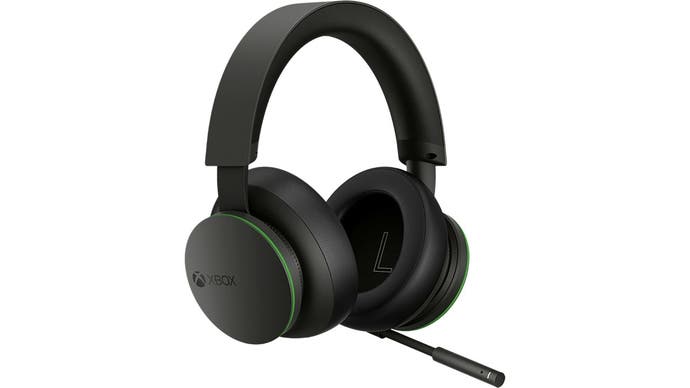
If I have the choice of Xbox or PlayStation headphones for PC, which should I choose?
In general, PlayStation headsets tend to work on PC and vice versa, so these can be a good choice if you don't have a horse in the console race. However, picking up the Xbox Wireless Adapter allows you to connect a few headsets that use a dongle-free connection to the Xbox, so these can be worth a look if you have an Xbox console.
How can I improve the sound of my existing headphones?
A lot of this comes down to personal preference, but we prefer to turn off audio "enhancements" like surround sound and aggressive equaliser settings; you want things to be as "bare metal" as possible if you trust in the intent of sound engineers and headphone designers alike. From there you can use a DAC, which takes audio processing duties off your PC or console and entrusts it instead to dedicated hardware which tends to do a better job, removing jitter and changing the characteristics of the sound for the better.
Desktop or portable DACs like the Audioengine D1, Fiio E10K or Cambridge Audio DacMagic XS cost around £100/$100 or less and can improve audio quality substantially. There are also the Epos GSX 300 and Helm Audio DB12 AAAMP we mentioned above. Of course, you can spend way more if you want to go even further into the audiophile realm.
What other outlets are worth reading?
As well as testing headsets ourselves, we like to look at trusted outlets like RTings and /r/headphones (summarised here). Some aspects of headphones can be quite subjective, so it's sensible to read widely, cross-reference where you can and try to find a few sites or reviewers that you generally agree with.
What about speakers?
Speakers are great for anyone that lives, works or games in their own space, but it's still worth having a good set of headphones for those inevitable times when you're sharing the place with someone else! If you're adamant on getting speakers too though, be sure to check out our round-up of the best computer speakers.
